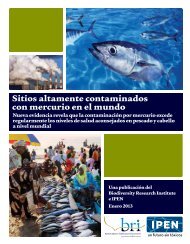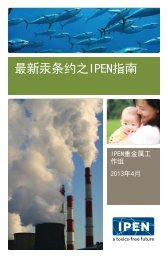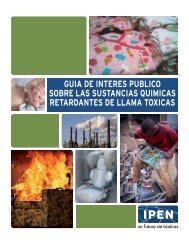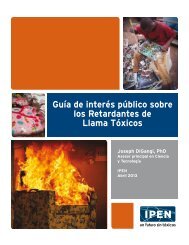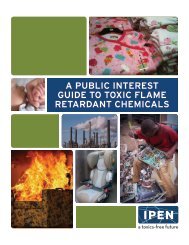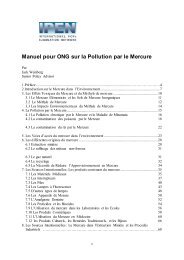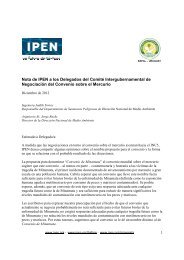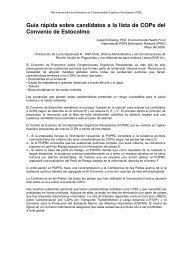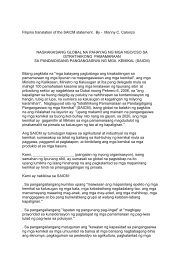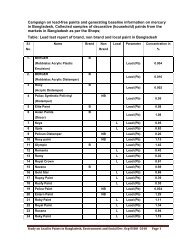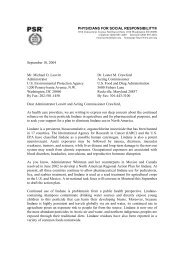The UNDP-GEF POPs Resource Kit - International POPs Elimination ...
The UNDP-GEF POPs Resource Kit - International POPs Elimination ...
The UNDP-GEF POPs Resource Kit - International POPs Elimination ...
Create successful ePaper yourself
Turn your PDF publications into a flip-book with our unique Google optimized e-Paper software.
concluded that there was sufficient scientific evidence for immediate action on 12 <strong>POPs</strong> 16 ,<br />
including a legally binding global instrument. <strong>The</strong> UNEP Governing Council subsequently<br />
requested (Decision 19/13) the Executive Director of UNEP, together with relevant<br />
international organizations, to convene an intergovernmental negotiating committee (INC) to<br />
prepare an international legally binding instrument for implementing international action on<br />
the 12 <strong>POPs</strong>. <strong>The</strong> Governing Council also requested UNEP to initiate immediate action on<br />
other recommendations of IFCS such as the: (a) development and sharing of information; (b)<br />
evaluation and monitoring of the success of implemented strategies; (c) alternatives to <strong>POPs</strong>;<br />
(d) identification and inventories of PCBs; (e) available destruction capacity; and (f)<br />
identification of sources of dioxins and furans and aspects of their management.<br />
<strong>The</strong> Role of the <strong>GEF</strong><br />
11. <strong>The</strong> involvement of the <strong>GEF</strong> in addressing global contaminants dates back to 1996<br />
when the <strong>GEF</strong> Operational Strategy and Contaminant-Based Operational Program (OP#10),<br />
in the <strong>International</strong> Waters focal area, were adopted. <strong>The</strong> strategic focus of the <strong>GEF</strong>’s<br />
assistance to countries includes supporting activities that demonstrate ways of overcoming<br />
barriers to the adoption of best practices which limit contamination of international waters by<br />
persistent toxic substances (PTS), including <strong>POPs</strong>, heavy metals, and organo-metallic<br />
compounds.<br />
12. In response to a finding of the <strong>GEF</strong> Overall Performance Evaluation that called for<br />
an increased effort in this field, the <strong>GEF</strong>, from March 1998-April 1999, defined near-term<br />
activities aimed at enhancing the <strong>GEF</strong>’s catalytic role. <strong>The</strong> objectives set forth in the program<br />
were rapidly met and a portfolio of strategically designed projects was developed under<br />
OP#10. It includes demonstrations of ways to build the capacity of client countries to<br />
reduce/eliminate the use/production of <strong>POPs</strong> in agriculture and in the control of vector<br />
diseases.<br />
13. Another effort, the “Regionally Based Assessment of Persistent Toxic Substances<br />
(PTS)” project, addresses the complexities, possible risks, and ecological/human health<br />
implications of the broader range of PTS. This project will provide within two years a better<br />
understanding of the overall dimensions of the threats posed by PTS, well beyond the 12<br />
substances initially considered for international action. A number of other projects addressing<br />
land-based sources of pollution, while not focused on <strong>POPs</strong>/PTS, have a <strong>POPs</strong>/PTS<br />
component.<br />
14. <strong>The</strong> <strong>GEF</strong> Council, at its 16 th session in November 2000, encouraged the<br />
Implementing and Executing Agencies and the <strong>GEF</strong> Secretariat to facilitate early action on<br />
the implementation of the <strong>POPs</strong> Convention and took note of the paper “Draft Elements of an<br />
Operational Program for Reducing and Eliminating Releases of Persistent Organic Pollutants<br />
16 <strong>The</strong> 12 <strong>POPs</strong> are: (a) Pesticides – aldrin, chlordane, DDT, dieldrin, endrin, heptachlor, hexachlorobenzene (also<br />
an industrial chemical and unintended by-product), mirex and toxaphene; (b) Industrial chemicals – PCBs (unintended<br />
by-products); and (c) unintended byproducts – dioxins and furans.<br />
110 ----------------------------------------------------------------------------------------<strong>UNDP</strong>-<strong>GEF</strong> <strong>POPs</strong> <strong>Resource</strong> <strong>Kit</strong>



